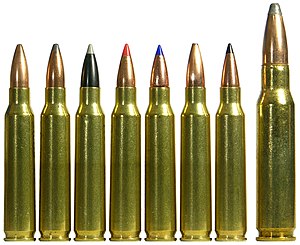.223
| .223 Remington | ||||||||||||||||||||||||
|---|---|---|---|---|---|---|---|---|---|---|---|---|---|---|---|---|---|---|---|---|---|---|---|---|

A variety of .223 Remington cartridges and a .308 Winchester (right) for comparison. Bullets in .223 cartridges (left to right): Montana Gold 55 grain Full Metal Jacket, Sierra 55 grain Spitzer Boat Tail, Nosler/Winchester 55 grain Combined Technology, Hornady 60 grain V-MAX, Barnes 62 grain Tipped Triple-Shock X, Nosler 69 grain Hollow Point Boat Tail, Swift 75 grain Scirocco II.
|
||||||||||||||||||||||||
| Type | Rifle | |||||||||||||||||||||||
| Place of origin | United States | |||||||||||||||||||||||
| Production history | ||||||||||||||||||||||||
| Designer | Remington Arms | |||||||||||||||||||||||
| Designed | 1962 | |||||||||||||||||||||||
| Produced | 1964–present | |||||||||||||||||||||||
| Variants | .223 Ackley Improved, 5.56×45mm NATO | |||||||||||||||||||||||
| Specifications | ||||||||||||||||||||||||
| Parent case | .222 Remington | |||||||||||||||||||||||
| Case type | Rimless, bottleneck | |||||||||||||||||||||||
| Bullet diameter | 0.224 in (5.7 mm) | |||||||||||||||||||||||
| Neck diameter | 0.253 in (6.4 mm) | |||||||||||||||||||||||
| Shoulder diameter | 0.354 in (9.0 mm) | |||||||||||||||||||||||
| Base diameter | 0.376 in (9.6 mm) | |||||||||||||||||||||||
| Rim diameter | 0.378 in (9.6 mm) | |||||||||||||||||||||||
| Rim thickness | 0.045 in (1.1 mm) | |||||||||||||||||||||||
| Case length | 1.76 in (45 mm) | |||||||||||||||||||||||
| Overall length | 2.26 in (57 mm) | |||||||||||||||||||||||
| Rifling twist | 1 in 12 inch (military style rifles use 1:7 to 1:10 to stabilize longer bullets) | |||||||||||||||||||||||
| Primer type | Small rifle | |||||||||||||||||||||||
| Maximum pressure (SAAMI) | 55,000 psi (380 MPa) | |||||||||||||||||||||||
| Maximum pressure (CIP) | 62,366 psi (430.00 MPa) | |||||||||||||||||||||||
| Maximum CUP | 52000 CUP | |||||||||||||||||||||||
| Ballistic performance | ||||||||||||||||||||||||
|
||||||||||||||||||||||||
|
Test barrel length: 24 inches (61 cm) Source(s): |
||||||||||||||||||||||||
The .223 Remington (.223 Rem) is a rifle cartridge. The name is commonly pronounced either two-twenty-three or two-two-three Remington. It is commercially loaded with 0.224 inch (5.56 mm) diameter jacketed bullets, with weights ranging from 40 to 85 grains (2.6 to 5.8 g), though the most common loading by far is 55 grains (3.6 g). A 90 gr Sierra Matchking bullet is available for reloaders. The .223 Rem was first offered to the civilian sporting market in December 1963 in the Remington 760 rifle. In 1964 the .223 Rem cartridge was adopted for use in the Colt M16 rifle which became an alternate standard rifle of the U.S. Army. The military version of the cartridge uses a 55 gr full metal jacket boattail design and was designated M193. In 1980 NATO modified the .223 Remington into a new design which is designated 5.56×45mm NATO type SS109.
1957: The development of the cartridge which eventually became the .223 Remington, from which the 5.56×45mm NATO will eventually be developed, is intrinsically linked to the development of a new lightweight combat rifle. The cartridge and rifle were developed as one unit by Fairchild Industries, Remington Arms, and several engineers working toward a goal developed by U.S. Continental Army Command (CONARC). Early development work begins in 1957. A project to create a Small Caliber High Velocity (SCHV) firearm is created. Eugene Stoner of Armalite is invited to scale down the AR-10 (7.62 mm) design. Winchester is also invited to participate. The parameters which are requested by CONARC are:
Springfield Armory's Earle Harvey lengthened the .222 Remington cartridge case to meet the requirements. It was then known as the .224 Springfield. Concurrently with the SCHV project Springfield armory is developing a 7.62 mm rifle. Harvey is ordered to cease all work on the SCHV to avoid any competition of resources.
Eugene Stoner of Armalite (a division of Fairchild Industries) had been advised to produce a scaled down version of the 7.62 mm AR-10 design. In May 1957 Stoner gives a live fire demonstration of the prototype of the AR-15 for General Wyman. As a result, CONARC orders rifles to test. Stoner and Sierra Bullet's Frank Snow begin work on the .222 Remington cartridge. Using a ballistic calculator they determine that a 55 grain bullet would have to be fired at 3,300fps to achieve the 500 yard performance necessary.
...
Wikipedia
